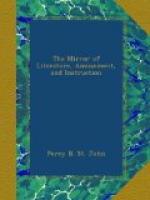The Yellow breasted Chat naturally follows his superior in the art of mimicry. When his haunt is approached, he scolds the passenger in a great variety of odd and uncouth monosyllables, difficult to describe, but easily imitated so as to deceive the bird himself, and draw him after you to a good distance. At first are heard short notes like the whistling of a duck’s wings, beginning loud and rapid, and becoming lower and slower, till they end in detached notes. There succeeds something like the barking of young puppies, followed by a variety of guttural sounds, and ending like the mewing of a cat, but much hoarser.
The song of the Baltimore Oriole is little less remarkable than his fine appearance, and the ingenuity with which he builds his nest. His notes consist of a clear mellow whistle, repeated at short intervals as he gleams among the branches. There is in it a certain wild plaintiveness and naivete extremely interesting. It is not uttered with rapidity, but with the pleasing tranquillity of a careless ploughboy, whistling for amusement. Since the streets of some of the American towns have been planted with Lombardy poplars, the orioles are constant visiters, chanting their native “wood notes wild,” amid the din of coaches, wheelbarrows, and sometimes within a few yards of a bawling oysterwoman.
The Virginian Nightingale, Red Bird, or Cardinal Grosbeak, has great clearness, variety, and melody in his notes, many of which resemble the higher notes of a fife, and are nearly as loud. He sings from March till September, and begins early in the dawn, and repeating a favourite stanza twenty or thirty times successively, and often for a whole morning together, till, like a good story too frequently repeated, it becomes quite tiresome. He is very sprightly, and full of vivacity; yet his notes are much inferior to those of the wood, or even of the brown thrush.




